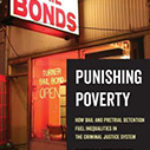Criminal Law And The Man Problem

Author: Ngaire Naffine
Publisher: London: Hart Publishing, 2019. 224p.
Reviewer: Lindsay Farmer | August 2021
Criminal lawyers are familiar with idea that widespread violence against women is under-reported and under-prosecuted. This is often seen as a problem of enforcement – indicating a need to change the policing, prosecution and enforcement of the law – rather than being seen as a problem of the law itself. It is also seen as a problem of female representation: recognising women in law so that women are included – primarily as victims, but also as perpetrators – in the realm of the criminal law. This might be described as the ‘woman’ problem of the criminal law: how to represent women in the criminal law. In her new book Ngaire Naffine challenges this in a blunt and disarming way. Criminal law does not have a woman problem, it has a ‘man problem’. This is the “problem of men permeating the discipline of criminal law in so thorough and yet natural-seeming a manner, that it is hard to see them at all, and it is also hard to convince that this is so” (p.1). In some ways this is a familiar reversal. As many have pointed out (as also does Naffine), to refer to violence against women makes that violence seem oddly disembodied: the problem is male violence, and rather than focusing on the object of that violence (women), we should focus on those who commit the violence. The problem is men. But what is new here is that this has not been said about the criminal law in such a direct way, and Naffine’s argument presents a fundamental challenge to many of the things criminal lawyers take for granted about the criminal law.
The ‘man problem’, as Naffine calls it, has two elements. First, men have made the world of criminal law, and are its interpreters, explainers, and justifiers, and because most violent criminals are men, they are also the subjects of the criminal law. This same subject of criminal law is usually presented as an abstract, disembodied, person, but is in fact a ‘person’ with only male characteristics, and this undermines any claims that the criminal law is equally concerned with the wrongdoing and welfare of all. Second, the maleness of criminal law is neither seen nor acknowledged. In fact, it is practically invisible precisely because of its pervasiveness. As Naffine suggests, try finding the subject ‘men’ in any textbook of criminal law. The ‘man problem’ is the elephant in the room – present but never acknowledged, and Naffine is surely right when she argues that criminal law will never truly be equal until it faces up to, and engages with, this fact about itself. The argument of the book is thus about the men who made the criminal law, about the way in which they saw (and see) the world, and how the supposedly neutral conceptual language of the criminal law in fact embodies or brings to life a certain kind of masculinity.
Naffine’s account of the man problem is focused on the crime of rape, and even more specifically the so-called marital rape exemption, only abolished in England in 1993. It is set out through an account of the ‘stomach-churning’ details of the English case of Morgan v DPP ([1975] AC 182) (p.9). This is a widely discussed case that (until the passing of the Sexual Offences Act 2003) was seen as authority for the view that an honest mistake made by a man about whether or not his female victim was consenting to sexual intercourse, even if it was based on unreasonable grounds, meant that there could be no mens rea to commit the crime of rape. Naffine details the violence inflicted on Daphne Morgan, the victim, while contrasting this with the second violence of the unemotive language of the law that denies that a rape could have taken place in the absence of this subjective belief in consent. She also points to an important feature of the case, often passed over in the many doctrinal and theoretical discussions of mens rea. This is that William Morgan, the husband, who instigated and participated in the attack, could not be charged with rape because of the marital rape immunity. And so we see the ‘man problem’ in a particularly stark form: a rule (the marital exemption) that was invented by men, justified by a series of male academic commentators, discussed in a neutral conceptual language by a court composed only of men erasing not only the experience of the female victim, but also its own maleness. The male presence and what it might mean for the criminal law is not acknowledged.
This focus on the crime of rape, and even more narrowly on the marital rape exemption, might seem paradoxical here: this is a crime that can only be committed by men (and until recently, at least in the UK, only against women). So of course this is a ‘man problem’! And the marital rape exemption was abolished nearly 30 years ago and so can be (and often is) viewed as an embarrassing historical anomaly, now safely in the past. (We should note, however, that according to 2017 World Bank Data there are still over 100 countries worldwide that do not criminalize marital rape. Importantly, however, Naffine draws out the wider significance of the example of marital rape as the basis for a more general claim about the ‘criminal legal world of men’ (Ch.2). This is the legal world made up of persons (without sex) and individuals with interests to be protected, where we can distinguish between actions and mental states and between intentions and motives. The subject is presumed to exist in nature before entering the world of law, but Naffine points out that this world, and the persons who populate it, is already a creation of a particular kind of legal imagination. The human imagined as the legal subject is already embodied in a certain way, “but this imaginative process is not discussed, nor probably noticed” (p.28). Her book, then, is an attempt to reconstruct this process of imagination and the place of women in this world.
This is in part a historical exercise, tracing changing attitudes towards marital rape through writers such as Sir Matthew Hale, James Fitzjames Stephen and Glanville Williams, and looking at what their writings can tell us about the world these men understood themselves to be living in. This is, to a great extent, a familiar history, as the figures she reviews, and the claims that they made, are well known – although Naffine also brings a refreshing new perspective by uncovering how, by act and omission, “they did not inquire into the way that the mores of their own sex served to delimit and modify the principles of … criminal law” (p.108). Perhaps more telling is her critique of contemporary criminal law and its scholars. Contemporary discourses of criminal law espouse gender neutrality and a commitment to equality, disavowing the overtly sexist positions of Hale, Stephen and Williams. Theorists adopt the female pronoun while speaking about the abstract legal subject and her interests, although this carries the unfounded implication that criminal law has a woman problem – that women are anti-social and violent. On this point, Naffine argues that the language of gender neutrality masks the fact that by speaking in an authoritative voice wrongs and harms are defined from a male perspective, in a way which brooks no disagreement (‘no one could possibly disagree’) and does not allow other perspectives, while simultaneously erasing the male writer (as a man) from that process of definition (ch.8). And she concludes by arguing that this repression, the failure to acknowledge the man problem, comes at a considerable cost to the criminal law in its aspiration to be fair and civilising. It forestalls other viewpoints or perspectives and erases the history of the discipline, creating a kind of epistemic injustice. The problem, indeed, going forward is whether “women can be modern legal individuals and women, and whether men can be modern civil persons and men” (p.174).
At this point I should acknowledge that I myself might be (or am!) part of the man problem of criminal law. Naffine is kind enough to acknowledge my own work on the history of the criminal law (and I also read much of the manuscript of the book in draft). But, in doing so she also makes me painfully aware of the fact that I somehow managed to write this history without fully seeing or engaging with the problem that she identifies – telling the history of criminal law without seeing that that history is, in her words, “very much a male world, peopled on the whole by men… [i]t is a story of male concerns, predilections, proclivities and rights… It is told as a story of the persons of criminal law, and how they have changed over time” (p.29). This is a timely and important reminder to me that, notwithstanding my own commitments to gender equality, it is all too easy to reproduce such habits of thought.
This is an important book, then, that challenges many of the things that we take for granted about the criminal law. It joins other recent important work, such as the Feminist Judgments projects, in confronting and engaging with the way that men have written and created the criminal law and what it means to bring other perspectives to bear on the writing and imagination of the criminal law. It is clear that criminal law does have a man problem and that it will no longer do just to pretend that it does not exist.
Lindsay Farmer, Professor of Law, University of Glasgow, UK


